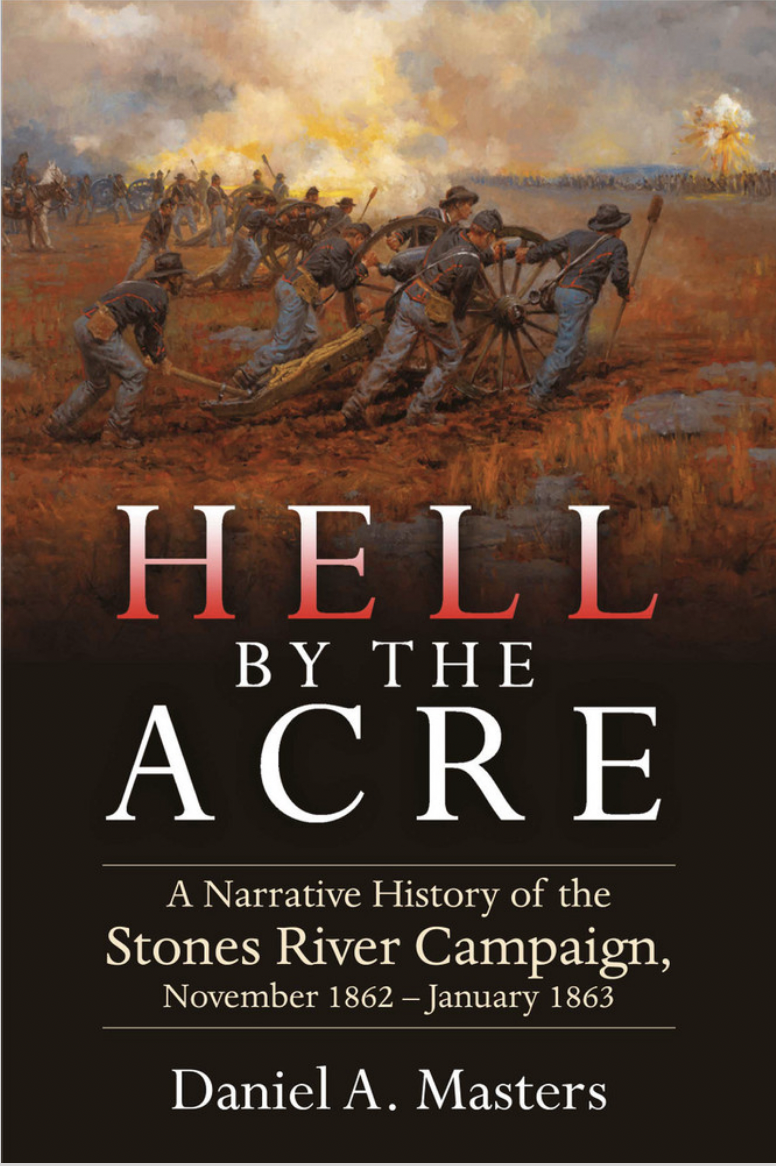 Image 1 of 1
Image 1 of 1


Hell by the Acre: A Narrative History of the Stones River Campaign, November 1862-January 1863
The waning days of 1862 marked a nadir in the fortunes of the Union. After major defeats at Fredericksburg in Virginia and Chickasaw Bayou in Mississippi, it fell to Maj. Gen. William S. Rosecrans and his Army of the Cumberland to secure a victory that would give military teeth to the Emancipation Proclamation set to take effect on January 1, 1863. On the day after Christmas, Rosecrans moved his army southeast out of Nashville to Murfreesboro, met Gen. Braxton Bragg’s Army of Tennessee, and fought one of the largest and bloodiest battles of the war. The full campaign, with extensive new source material and coverage, is the subject of Daniel Masters’s new Hell by the Acre: A Narrative History of the Stones River Campaign, November 1862–January 1863.
The opposing armies—44,000 men under Rosecrans and 37,000 under Bragg—locked bayonets on December 31, 1862, in some of the hardest fighting of the war. Bragg’s initial attack drove the Federals back nearly three miles, captured 29 cannons, and thousands of prisoners. Somehow the Union lines held firm during the critical fighting along the Nashville Pike that afternoon against repeated determined attacks that left both armies bloodied and exhausted. The decisive moment came two days later when, in the fading afternoon of January 2, 1863, Bragg launched an assault on an isolated Union division on the east bank of Stones River. Once again, the Confederates enjoyed initial success only to be repulsed by 58 Union guns arrayed along the west bank and a daring counterattack. This repulse broke Bragg’s hold on Murfreesboro. He retreated the following night, leaving Rosecrans and his Cumberland army victors of the field.
Prior Stones River books, each excellent in its own way, focused on strategy, tactics, and high-level command decisions. Masters ably examines all these issues in a study carefully constructed to also present the view from the soldiers who fought the battle. His masterful use of hundreds of archival and firsthand accounts, many of which have never been published, sheds significant new light on the experiences of the front-line troops. Hell by the Acre is an unparalleled view of Civil War combat and tactical command from the men who pulled the triggers.
Stones River marked a turning point for Federal fortunes in the Western Theater, and this fresh and original study sets forth the hefty cost of securing that victory for the Union.
Hardcover. 672 pages
The waning days of 1862 marked a nadir in the fortunes of the Union. After major defeats at Fredericksburg in Virginia and Chickasaw Bayou in Mississippi, it fell to Maj. Gen. William S. Rosecrans and his Army of the Cumberland to secure a victory that would give military teeth to the Emancipation Proclamation set to take effect on January 1, 1863. On the day after Christmas, Rosecrans moved his army southeast out of Nashville to Murfreesboro, met Gen. Braxton Bragg’s Army of Tennessee, and fought one of the largest and bloodiest battles of the war. The full campaign, with extensive new source material and coverage, is the subject of Daniel Masters’s new Hell by the Acre: A Narrative History of the Stones River Campaign, November 1862–January 1863.
The opposing armies—44,000 men under Rosecrans and 37,000 under Bragg—locked bayonets on December 31, 1862, in some of the hardest fighting of the war. Bragg’s initial attack drove the Federals back nearly three miles, captured 29 cannons, and thousands of prisoners. Somehow the Union lines held firm during the critical fighting along the Nashville Pike that afternoon against repeated determined attacks that left both armies bloodied and exhausted. The decisive moment came two days later when, in the fading afternoon of January 2, 1863, Bragg launched an assault on an isolated Union division on the east bank of Stones River. Once again, the Confederates enjoyed initial success only to be repulsed by 58 Union guns arrayed along the west bank and a daring counterattack. This repulse broke Bragg’s hold on Murfreesboro. He retreated the following night, leaving Rosecrans and his Cumberland army victors of the field.
Prior Stones River books, each excellent in its own way, focused on strategy, tactics, and high-level command decisions. Masters ably examines all these issues in a study carefully constructed to also present the view from the soldiers who fought the battle. His masterful use of hundreds of archival and firsthand accounts, many of which have never been published, sheds significant new light on the experiences of the front-line troops. Hell by the Acre is an unparalleled view of Civil War combat and tactical command from the men who pulled the triggers.
Stones River marked a turning point for Federal fortunes in the Western Theater, and this fresh and original study sets forth the hefty cost of securing that victory for the Union.
Hardcover. 672 pages
